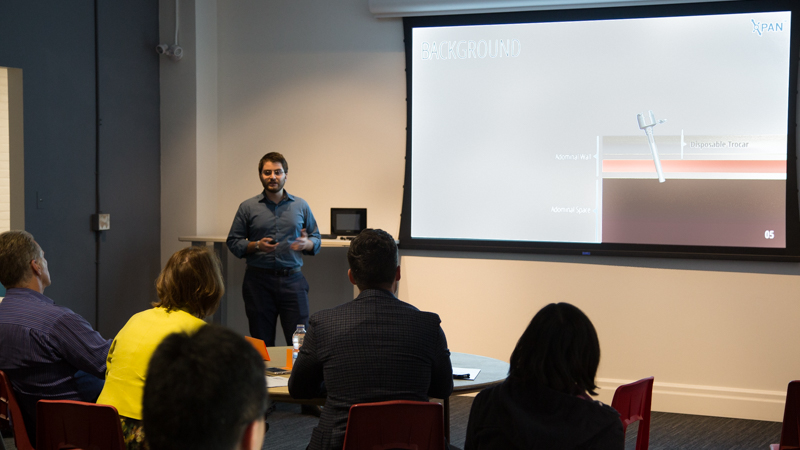Mobile Menu
- Education
- Research
-
Students
- High School Outreach
- Undergraduate & Beyond: Community of Support
- Current Students
- Faculty & Staff
- Alumni
- News & Events
- Giving
- About

 Around the world, 15 million laparoscopic operations are performed each year. Also known as ‘keyhole’ surgeries, these procedures help reduce infection risk, blood loss and recovery time. But, in some of these minimally invasive surgeries, doctors need to remove the device used to create a tunnel into the patient’s abdomen — called a “trocar” — to replace it with a larger one in order to use bigger tools. Three recent U of T graduates launched a start-up called Xpan to solve this problem. Zaid Atto, Seray Cicek and Chevis Dilbert created a trocar that allows laparoscopic tools to be used interchangeably. The team recently won one of three Student Innovation Fellowship prizes through the H2i Pitch Perfect Competition. Faculty of Medicine writer Erin Howe spoke with Atto and Cicek about their invention.
Around the world, 15 million laparoscopic operations are performed each year. Also known as ‘keyhole’ surgeries, these procedures help reduce infection risk, blood loss and recovery time. But, in some of these minimally invasive surgeries, doctors need to remove the device used to create a tunnel into the patient’s abdomen — called a “trocar” — to replace it with a larger one in order to use bigger tools. Three recent U of T graduates launched a start-up called Xpan to solve this problem. Zaid Atto, Seray Cicek and Chevis Dilbert created a trocar that allows laparoscopic tools to be used interchangeably. The team recently won one of three Student Innovation Fellowship prizes through the H2i Pitch Perfect Competition. Faculty of Medicine writer Erin Howe spoke with Atto and Cicek about their invention.
What inspired your expandable laparoscopic surgery tool?
Atto: We’re recent Biomedical Engineering graduates from the Department of Engineering Science. Through our final year capstone project, we learned how surgeons sometimes need to remove a trocar during a procedure to replace it with a larger one to use larger tools. Because the trocar is like a tunnel that other equipment needs to fit through — sometimes more room is required mid-procedure. Priscilla Chiu, an assistant professor in the Department of Surgery and staff surgeon in general and thoracic surgery at The Hospital for Sick Children had brought this problem to one of our instructors. We thought, what if there was a way to allow larger instruments to be used without having to remove and replace trocars?
Cicek: Both of our fathers have had laparoscopic surgeries. There were complications during my dad’s operation and instead of being in the hospital for one day, he had to stay for three. We don’t know if our trocar might have helped prevent the complications my dad experienced, but there will be cases when it could save people days in hospital. Knowing we can make a change motivates us.
How will Xpan improve surgical outcome?
Cicek: Replacing a trocar mid-surgery has the potential to expose patients to more risk. It also adds time and expense to the procedure. Our device will prevent these problems.
Atto: In addition, our tool gives surgeons flexibility and convenience they didn’t have before.
Who has mentored or inspired you here at U of T?
Atto: Dr. Chiu is our clinical advisor and continues to inspire us. Chris Bouwmeester, an assistant professor in IBBME, was one of the capstone instructors at IBBME. He along with Profesor Chris Yip, who is appointed to the Department of Chemical Engineering and Applied Chemistry, the Department of Biochemistry and IBBME, have supported us through our journey, allowing us to tap into a variety of resources. We are also inspired by highly accomplished medtech innovators such as Professor Paul Santerre — he was an instructor of ours — and Dr. Brian Courtney, and the companies they have founded.
What’s next for this project?
Atto: We already have a provisional patent in place and we are working on improving our prototype and getting it to the point where we can test it in an animal model. Next, we want to form partnerships with major research institutes or hospitals, where we can do more pre-clinical research.
Is there hope to expand your line of products one day?
Atto: We’ve got many ideas! As we keep talking to surgeons, our plan is to develop a company with several products and solve clinical problems.